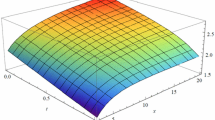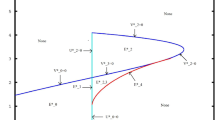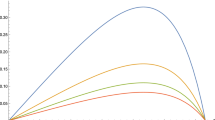Abstract
The economics of harvesting a renewable natural resource is well-developed in a framework where environmental conditions of the species looked at are kept constant. For the case of two interacting species as a prey-predator relationship the economics of harvesting one of the two species is analyzed. Questions of existence, uniqueness, and stability are looked at. Applying optimal control theory, a modified golden rule of harvesting is derived.
Similar content being viewed by others
References
Anderson, L. G. (1982): “Marine Fisheries.” InCurrent Issues in Natural Resources Policy, edited by P. R. Portney and R. B. Haas. Baltimore: John Hopkins.
Beddington, J. R., and May, R. M. (1980): “Maximum Sustainable Yields in Systems Subject to Harvesting at More than One Trophic Level,”Mathematical Biosciences 51: 261–281.
— (1982): The Harvesting of Interacting Species in a Natural Ecosystem.”Scientific American 247: 42–49.
Berck, P., and Sydsaeter, K. (1991):Economists' Mathematical Manual. Berlin: Springer.
Brauer, F., and Soudack, A. C. (1979): “Stability Regions and Transition Phenomena for Harvested Predator-Prey Systems.”Journal of Mathematical Biology 7: 319–337.
Bulmer, M. G. (1976): “The Theory of Prey-Predator Oscillations.”Theoretical Population Biology 9: 137–150.
Clark, C. W. (1976):Mathematical Bioeconomics: the Optimal Management of Renewable Resources. New York: Wiley.
— (1982): “Models of Fishery Regulation.” InEssays in the Economics of Renewable Resources edited by L. J. Mirman and D. F. Spulber. Amsterdam: North-Holland.
Clark, C. W., and Munro, G. R. (1975): “Economics of Fishing and Modern Capital Theory: a Simplified Approach.”Journal of Environmental Economics and Management 2: 92–106.
Flaaten, O. (1988):The Economics of Multispecies Harvesting: Theory and Application to the Barents Sea Fisheries. Berlin: Springer.
Gauze, G. F. (1964):The Struggle for Existence. New York: Hafner.
Goh, B. S. (1976): “Global Stability in Two-Species Interactions.”Journal of Mathematical Biology 3: 313–318.
Goh, B. S., Leitman, G., and Vincent, T. L. (1974): “Optimal Control of a Predator-Prey System.”Mathematical Biosciences 19: 263–286.
Kamien, M. I., and Schwartz, N. L. (1981):Dynamic Optimization, The Calculus of Variations and Optimal Control in Economics and Management, 2nd edn. Amsterdam: North-Holland.
Larkin, P. A. (1963): “Interspecific Competition and Exploitation.”Journal of the Fisheries Research Board of Canada 23: 647–678.
— (1966): “Exploitation in a Type of Predator-Prey Relationship”.Journal of the Fisheries Research Board of Canada 23: 349–356.
Leslie, P. H. (1948): “Some Further Notes on the Use of Matrices in Population Mathematics.”Biometrics 35: 213–245.
Lotka, A. J. (1925):Elements of Physical Biology. Baltimore: Williams and Wilkins.
May, R. M. (1980): “Modelle für zwei interagierende Populationen.” InTheoretische Ökologie, edited by R. M. May, Weinheim: VCH.
Quirk, J. P., and Smith, V. L. (1970): “Dynamic Economic Models of Fishing.” InEconomics of Fisheries Management: a Symposium edited by A. D. Scott. Vancouver: University of British Columbia.
Ragozin, D. (1982): “Self-regulating Two Species Systems Have no Limit Cycles.” Mimeo, University of Washington.
Samuelson, P. A. (1967): “A Universal Cycle?”Operations Research Verfahren 3: 170–183.
Steele, H. H., and Henderson, E. W. (1984): “Modelling Long-term Fluctuations in Fish Stocks.”Science 224: 985–987.
Ströbele, W. J., and Wacker, H. (1991): The Concept of Sustainable Yield in Multi-Species Fisheries.”Ecological Modelling 53: 61–74.
Volterra, V. (1928): “Variations and Fluctuations of the Number of Individuals in Animal Species Living Together.”Journal du Conseil 3: 1–51.
Author information
Authors and Affiliations
Rights and permissions
About this article
Cite this article
Ströbele, W.J., Wacker, H. The economics of harvesting predator-prey systems. Zeitschr. f. Nationalökonomie 61, 65–81 (1995). https://doi.org/10.1007/BF01231484
Received:
Revised:
Issue Date:
DOI: https://doi.org/10.1007/BF01231484




